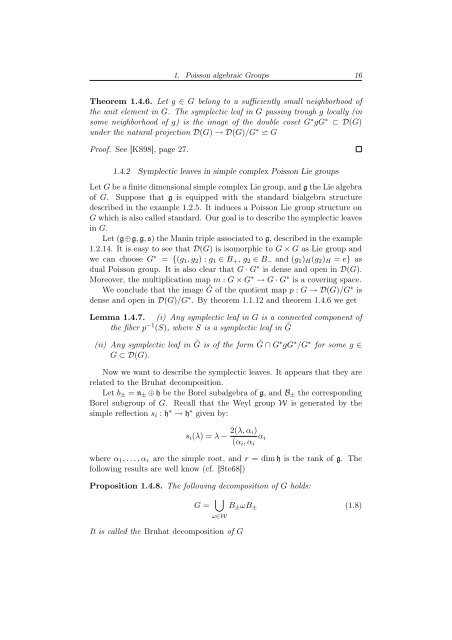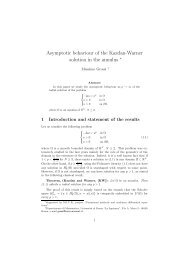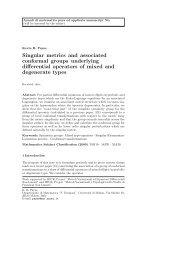Degree of Parabolic Quantum Groups - Dipartimento di Matematica ...
Degree of Parabolic Quantum Groups - Dipartimento di Matematica ...
Degree of Parabolic Quantum Groups - Dipartimento di Matematica ...
You also want an ePaper? Increase the reach of your titles
YUMPU automatically turns print PDFs into web optimized ePapers that Google loves.
1. Poisson algebraic <strong>Groups</strong> 16<br />
Theorem 1.4.6. Let g ∈ G belong to a sufficiently small neighborhood <strong>of</strong><br />
the unit element in G. The symplectic leaf in G passing trough g locally (in<br />
some neighborhood <strong>of</strong> g) is the image <strong>of</strong> the double coset G ∗ gG ∗ ⊂ D(G)<br />
under the natural projection D(G) → D(G)/G ∗ ⋍ G<br />
Pro<strong>of</strong>. See [KS98], page 27.<br />
1.4.2 Symplectic leaves in simple complex Poisson Lie groups<br />
Let G be a finite <strong>di</strong>mensional simple complex Lie group, and g the Lie algebra<br />
<strong>of</strong> G. Suppose that g is equipped with the standard bialgebra structure<br />
described in the example 1.2.5. It induces a Poisson Lie group structure on<br />
G which is also called standard. Our goal is to describe the symplectic leaves<br />
in G.<br />
Let (g⊕g, g, s) the Manin triple associated to g, described in the example<br />
1.2.14. It is easy to see that D(G) is isomorphic to G × G as Lie group and<br />
we can choose G ∗ = {(g1, g2) : g1 ∈ B+, g2 ∈ B− and (g1)H(g2)H = e} as<br />
dual Poisson group. It is also clear that G · G ∗ is dense and open in D(G).<br />
Moreover, the multiplication map m : G × G ∗ → G · G ∗ is a covering space.<br />
We conclude that the image ˜ G <strong>of</strong> the quotient map p : G → D(G)/G ∗ is<br />
dense and open in D(G)/G ∗ . By theorem 1.1.12 and theorem 1.4.6 we get<br />
Lemma 1.4.7. (i) Any symplectic leaf in G is a connected component <strong>of</strong><br />
the fiber p −1 (S), where S is a symplectic leaf in ˜ G<br />
(ii) Any symplectic leaf in ˜ G is <strong>of</strong> the form ˜ G ∩ G ∗ gG ∗ /G ∗ for some g ∈<br />
G ⊂ D(G).<br />
Now we want to describe the symplectic leaves. It appears that they are<br />
related to the Bruhat decomposition.<br />
Let b± = n± ⊕ h be the Borel subalgebra <strong>of</strong> g, and B± the correspon<strong>di</strong>ng<br />
Borel subgroup <strong>of</strong> G. Recall that the Weyl group W is generated by the<br />
simple reflection si : h ∗ → h ∗ given by:<br />
si(λ) = λ −<br />
2(λ, αi)<br />
αi<br />
(αi, αi<br />
where α1, . . .,αr are the simple root, and r = <strong>di</strong>m h is the rank <strong>of</strong> g. The<br />
following results are well know (cf. [Ste68])<br />
Proposition 1.4.8. The following decomposition <strong>of</strong> G holds:<br />
G = <br />
B±ωB±<br />
ω∈W<br />
It is called the Bruhat decomposition <strong>of</strong> G<br />
(1.8)








